
CAS Newsletter 2006 / No 2
Articles, pictures and interviews can be reprinted only with the consent of Centre for Advanced Study Sofia (CAS - Sofia). Any citations should be duly acknowledged.
More...We kindly inform you that, as long as the subject affiliation of our 300.000+ articles is in progress, you might get unsufficient or no results on your third level or second level search. In this case, please broaden your search criteria.

Articles, pictures and interviews can be reprinted only with the consent of Centre for Advanced Study Sofia (CAS - Sofia). Any citations should be duly acknowledged.
More...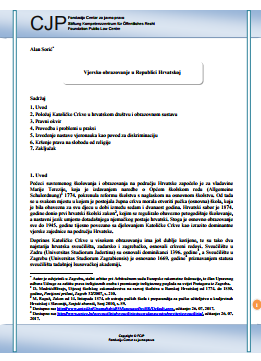
This paper investigates issues relating to religious education in public school system in the Republic of Croatia. It focuses mainly on Catholic Catechism in public school, due to the fact that population of Croatia is predominantly Catholic and the fact that Croatia has entered into international accords with Holy See. Paper particularly analyzes and describes instances of discrimination of nonreligious school children and criticizes the fact that no alternative education is provided to such children, at least in the first three grades of elementary schools. Finally, the paper offers certain recommendations to mitigate existing problems and to eliminate discrimination from public school system of the Republic of Croatia.
More...
Isprepletenost i podudarnost etničke i religijske pripadnosti u BiH direktno se odražava na položaj religijskih manjina u BiH. Zbog takve karakteristične strukture, gdje se svi napori usmjeravaju ka pružanju jednakog tretmana trima većinskim religijama, prava religijskih manjina ostaju zapostavljena. Iako su na snazi mnogi pravni propisi koji garantiraju jednak položaj svih religijskih zajednica, religijske manjine se svakodnevno stavljaju u obespravljen položaj. To je na primjer vidljivo iz činjenica da Ustav Republike Srpske navodi Srpsku pravoslavnu crkvu kao crkvu srpskog naroda i drugih naroda pravoslavne vjere, te da religijske manjine nisu zastupljene u Međureligijskom vijeću BiH. Pored toga, obespravljenost religijskih manjina dolazi do izražaja i u koncepciji religijskog obrazovanja u školama, gdje u većini slučajeva učenici nisu u mogućnosti da pohađaju religijsko obrazovanje po svom izboru, nego zbog konretnih okolnosti moraju konzumirati vjersku pouku većinske religije. Problemi sa legislativom u BiH, kao što su neharmoniziranost te siromašna zakonska zaštita od diskriminacije, samo dodatno doprinose marginalizaciji religijskih manjina u društvu. Zbog pojedinih Ustavnih odredbi koje omogućuju povlašteni položaj određenoj religiji i uske povezanosti religije i politike, BiH sve više postaje polusekularna država, u kojoj se za vođstvo takmiče tri većinske religije. Iz svega navedenog slijedi da bi vlasti BiH trebale poduzeti različite mjere kako bi se religijske manjine zaštitile od diskriminacije. Prvi korak bi predstavljalo ukidanje odredbe Ustava Republike Srpske, kojom se daje povlašteni položaj Srpskoj pravoslavnoj crkvi. Dalje, religijske manjine treba da budu zastupljene u organima Međureligijskog vijeća u BiH. Aktivnim djelovanjem Međureligijskog vijeća bi se mogao znatno poboljšati položaj religijskih manjina u društvu. Pored toga, vlasti BiH bi trebale poduzeti korake kako bi harmonizirale i ojačale zakone vezane za zaštitu od krivičnog djela poticanja na mržnju. Iako krivična djela počinjena iz mržnje prema religijskim manjinama nisu česta pojava u BiH, ipak stručnjaci za ljudska prava ukazuju na njihovo postojanje. Stoga bi harmonizacija zakonodavstva znatno olakšala sudijama i tužiocima sankcioniranje krivičnog djela poticanje na mržnju, što bi opt doprinijelo ujednačavanju sudske prakse, a time i efektivnijoj zaštiti i prevenciji od sličnih krivičnih djela. Na posljetku, jedna od ključnih stvari za uklanjanje diskriminacije religijskih manjina u BiH jeste izmjena dosadašnjeg načina religijskog obrazovanja u školama. Umjesto vjerske pouke o samo jednoj religiji, učenici treba da se educiraju o različitim kulturama i religijama. Kao što je predhodno navedeno, zbog okolnosti, škole su ograničene u pogledu pružanja vrste religijskog obrazovanja, tako da bi ovakva opcija bila prikladna za učenike svih vjeroispovijesti, kod kojih bi se ujedno i razvijala svijest o važnosti tolerancije i ravnopravnosti u društvu.
More...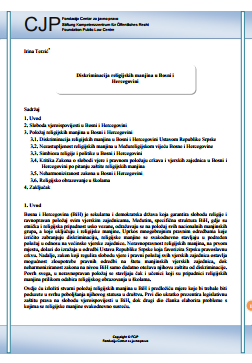
Isprepletenost etničke i religijske pripadnosti u BiH se direktno odražava na položaj religijskih manjina u BiH. Zbog takve karakteristične strukture, gdje se svi napori usmjeravaju ka pružanju jednakog tretmana trima većinskim religijama, prava religijskih manjina ostaju zapostavljena. Iako su na snazi mnogi pravni propisi koji garantiraju jednak položaj svih religijskih zajednica, religijske manjine se svakodnevno stavljaju u obespravljen položaj. Na primjer, to je vidljivo iz činjenica da Ustav Republike Srpske navodi Srpsku pravoslavnu crkvu kao crkvu srpskog naroda i drugih naroda pravoslavne vjere, te da religijske manjine nisu zastupljene u Međureligijskom vijeću BiH. Pored toga, obespravljenost religijskih manjina dolazi do izražaja prilikom religijskog obrazovanja u školama, gdje u većini slučajeva učenici nisu u mogućnosti da pohađaju religijsko obrazovanje po svom izboru, nego zbog okolnosti pristaju na vjersku pouku većinske religije. Problemi sa legislativom u BiH, kao što su neharmoniziranost, te siromašna zakonska zaštita od diskriminacije, samo dodatno doprinose marginalizaciji religijskih manjina u društvu. Zbog pojedinih ustavnih odredbi, gdje se povlašteni položaj daje određenoj religiji, te uske povezanosti religije i politike, BiH sve više daje utisak polusekularne države, u kojoj se za vođstvo takmiče tri većinske religije. Iz svega navedenog je očito da bi vlasti BiH trebale poduzeti različite mjere kako bi religijske manjine zaštitile od diskriminacije. Prvi korak ka tome je ukinuti odredbu Ustava Republike Srpske, kojom se daje povlašteni položaj Srpskoj pravoslavnoj crkvi. Dalje, religijske manjine treba da budu zastupljene u organima Međureligijskog vijeća u BiH. Aktivnim djelovanjem Međureligijskog vijeća mogao bi se znatno poboljšati položaj religijskih manjina u društvu. Pored toga, vlasti BiH bi trebale poduzeti korake kako bi harmonizirali i ojačali zakone vezane za zaštitu od krivičnog djela poticanja na mržnju. Iako krivična djela počinjena iz mržnje prema religijskim manjinama nisu česta pojava u BiH, ipak stručnjaci za ljudska prava su ukazali na njihovo postojanje. Stoga, harmonizacija zakonodavstva bi znatno olakšala sudijama i tužiocima sankcioniranje krivičnog djela poticanje na mržnju, što bi doprinijelo konzinstentnosti sudske prakse, a time i efektivnijoj zaštiti i prevenciji od sličnih zločina. Naposljetku, jedna od ključnih stvari za uklanjanje diskriminacije religijskih manjina u BiH jeste izmjena dosadašnjeg načina religijskog obrazovanja u školama. Umjesto vjerske pouke o samo jednoj vrsti religije, učenici treba da se educiraju o različitim kulturama i religijama. Kao što je prethodno navedeno, zbog okolnosti, škole su ograničene u pogledu pružanja vrste religijskog obrazovanja, tako da bi ovakva opcija bila prikladna za učenike svih vjeroispovijesti, kod kojih bi se ujedno i razvijala svijest o važnosti tolerancije i ravnopravnosti u društvu.
More...
The author analyzes the introduction of health education, including sex education, into the system of compulsory primary and secondary education in the Republic of Croatia, from the first initiative of the late 90s to the present time. The author writes about public controversy between traditionally conservative and liberally progressive social forces regarding the right of parents, who hold certain world views to make independent decisions about the education of children, and, on the other hand, the constitutional obligation of the State to ensure children's right to a full and harmonious development of their personalities. The issue is addressed from the perspective of the case law of the European Court of Human Rights, which has already dealt with this issue, and the decision of the Constitutional Court of the Republic of Croatia, which emphasizes the importance of democratic, pluralistic approach in the creation of educational contents, especially when it comes to sexual education of children. How to put an end to the controversy, whose intent is to dispute the school's program of sex education on the basis of religious and/or political beliefs, still is an open question.
More...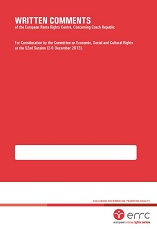
The European Roma Rights Centre (ERRC) hereby submits this report to the United Nations Human Rights Council (HRC) for the universal periodic review of France’s compliance with its human rights commitments. This report focuses on housing, forced evictions, access to water and sanitation.
More...
The European Roma Rights Centre (ERRC) is a Roma-led international public interest law organisation which monitors the human rights of Roma in Europe and provides legal defence in cases of human rights violations. The ERRC is deeply concerned at the lack of progress made by Bulgarian authorities since CERD issued its concluding observations on Bulgaria in 2009 with specific reference to the committee’s recommendations concerning the situation of Roma and other minorities. Bulgarian authorities continue to target Romani communities for forced evictions, and the de facto segregation of Roma continues in all areas of life, in particular in the spheres of residential segregation and segregation in healthcare facilities. Limited progress has been made with regards to enforcing legislation persecuting racially motivated hate crimes. Hate speech continues to affect Romani minorities in particular, leading to a number of instances of violence. In a number of cases, Bulgarian authorities have failed to protect Romani citizens from violent racist mobs attacking Romani communities and individuals. This submission also finds that CERD’s calls for improving the situation of Roma in all areas of life, in particular of access to healthcare and housing, have yet to be adequately addressed.
More...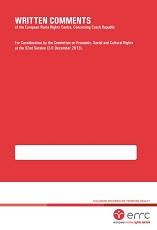
The European Roma Rights Centre (ERRC) submits this parallel report to the Human Rights Committee reporting country-specific information on issues affecting Roma in Serbia that raise questions under the Covenant on Civil and Political Rights (CCPR). The present report describes the current situation regarding serious human rights abuses of Roma in Serbia – school segregation, ethnic discrimination and lack of birth registration. The ERRC respectfully submits its written comments concerning Serbia for consideration by the Covenant on Civil and Political Rights (CCPR) at its Concluding Observations of the 119th Session, which will be held from 6 to 29 March 2017. The ERRC has undertaken regular monitoring of the human rights situation of Roma in Serbia and this report reflects the current priorities in our work in Serbia. According to current official estimates, Roma in Serbia make up approximately 2.05% of the total population or 147,604 Roma. This makes Roma the second largest minority after Hungarians. However, a verified and accurate count remains elusive. Unofficial sources suggest that the number of Roma in Serbia is significantly higher, ranging between 250,000 to 500,000. In addition to the autochthonous groups, an estimated to 50,000 Roma fled during and after the conflict in Kosovo to Serbia; only half of whom registered as internally displaced persons (IDPs). However, it is not known if all of them remained in Serbia or left for destinations in Western Europe. Furthermore, thousands of Roma have been returned to Serbia from Western European countries in the last years as failed asylum seekers; including Roma who were originally from Kosovo. Roma are the youngest ethnic group in Serbia. The average age is 27.5 years, compared to 40.2 years among the general Serbian population. According to UNICEF, the primary school completion rate for non-Roma children is 94.5% and the transition rate to secondary school is 96.5%, while for Roma children the primary school completion rate is considerably lower - 63%, while the numbers for secondary school for Roma youngsters is even lower - 55.5%. Illiteracy rates range between age groups from 13.7% amongst adolescents to 57.2% among the elderly. Romani women are extremely disadvantaged when it comes to education achievements; illiteracy is estimated to reach up to 80%.
More...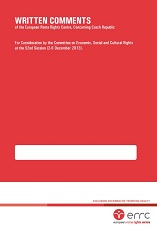
The European Roma Rights Centre (ERRC) and Praxis respectfully submit their written comments concerning Serbia for consideration by the Committee on the Rights of the Child (CRC) at its Concluding Observations of the 74th Session, which will be held from 16 January to 3 February 2017. The ERRC and Praxis have undertaken regular monitoring of the human rights situation of Roma in Serbia and this report reflects the current priorities in our work in Serbia. According to current official estimates, Roma in Serbia make up approximately 2.05% of the total population or 147,604 Roma. This makes Roma the second largest minority after Hungarians. However, a verified and accurate count remains elusive. Unofficial sources suggest that the number of Roma in Serbia is significantly higher, ranging between 250,000 to 500,000. In addition to the autochthonous groups, approximately 4,000 –50,000 Roma fled during and after the conflict in Kosovo to Serbia; only half of whom registered as internally displaced persons (IDPs). However, it is not known if all of them remained in Serbia or left for destinationsin Western Europe. Furthermore, thousands of Roma have been returned to Serbia from Western Europeancountries in the last years as failed asylum seekers; including Roma who were originally from Kosovo.Roma are the youngest ethnic group in Serbia. The average age is 27.5 years, compared to 40.2 years among the general Serbian population. According to UNICEF, the primary school completion rate for non-Roma children is 94.5% and the transition rate to secondary school is 96.5%, while for Roma children the primary school completion rate considerably lower - 63%, while the numbers for secondary school for Roma youngsters is even lower - 55.5%. Illiteracy rates range between age groups from 13.7% amongst adolescents to 57.2% among the elderly. Romani women are extremely disadvantaged when it comes to education achievements; illiteracy is estimated to reach up to 80%.
More...
The Center for Civil and Human Rights (Poradňa pre občianske a ľudské práva, hereinafter also referred to as „Poradňa“) and the European Roma Rights Centre (hereinafter also referred to as “ERRC”) hereby jointly submit this report to the United Nations Committee on the Rights of the Child (hereinafter also referred to as “Committee”) for the consideration at its 72nd Session (17 May 2016 – 03 June 2016). The report provides updates on the issues disproportionately impacting Romani children in Slovakia, which were brought to the attention of the Committee before its 72nd Pre-sessional Working Group, including: - police ill-treatment and harassment; - Q access to water and sanitation; - discrimination of Romani children in education; - segregation of Romani patients, including children, in hospitals; - the practice of sterilisation of Romani girls without parental and informed consent. The report we submitted to the Committee for the Pre-sessional Working Group included also chapters on discriminatory legislation, adequate standard of living and Romani children in institutional care. However, the submitting NGOs have not registered updates in relation to them that is why they are not included in this alternative report although the violations described in these areas still persist and we request the Committee to consider them during the constructive dialogue with Slovak representatives during the Session.
More...
The European Roma Rights Centre (ERRC) is a Roma-led international public interest law organisation working to combat anti-Romani racism and human rights abuse of Roma through strategic litigation, research and policy development, advocacy and human rights education. In May 2016, the ERRC responded to the European Commission’s request for input regarding the forthcoming annual Progress Reports for the current candidate countries of Albania, the former Yugoslav Republic of Macedonia, Montenegro, Serbia and Turkey. The ERRC comments cover only those areas which have been monitored by the ERRC and its partners. The submission makes no claims to be comprehensive: comments and observations are confined to ERRC’s strategic priorities and reflect the organisation’s activities, advocacy and research in those particular countries over the past year.
More...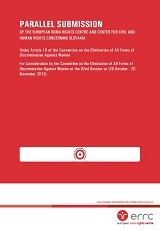
The Center for Civil and Human Rights (Poradňa pre občianske a ľudské práva, hereinafter also referred to as „Poradňa“) and the European Roma Rights Centre (hereinafter also referred to as “ERRC”) hereby jointly submit this report to the United Nations Committee on the Elimination of All Forms of Discrimination Against Women (CEDAW) commenting on the Combined Fifth and Six Periodic Report of Slovakia, submitted under Article 18 of the United Nations Convention on the Elimination of All Forms of Discrimination against Women (Convention). The present shadow report focuses on the issues disproportionately impacting Romani women: insufficient access of Romani women to justice in cases of their multiple discrimination, discrimination in education, health care and missing compensation and safeguard provisions for involuntary sterilisation of Romani women. The report describes the current situation regarding one of the most serious human rights abuses of women – the practice of coercive sterilisation of Romani women – and the legal, policy and other obstacles in reaching an effective remedy for the victims. The submission focuses only on issues directly related to the practice of coercive sterilisation; i.e. Articles 10 (equal access to education), 12 (equal access to health care services) and 16 (freedom from discrimination in all matters relating to marriage and family relations) of the Convention. This report aims to provide an update on the situation since 2008 when CEDAW last reviewed Slovakia. It includes an update on the legislative changes, compensation mechanism proposals, updates on court cases, comments on the information provided by the Slovak government and recommendations for government action. In its 2008 Concluding observations (CEDAW/C/SVK/CO/4), the Committee recommended Slovak government to developed specific measures to tackle discrimination against Romani women (discrimination of Romani women: paras 36 and 37, coercive sterilisation: paras 43 and 44). Submitting organizations are concerned that Slovakia has done little to address the Committee’s concerns and recommendations for the situation of Romani women and that progress in complying with the Convention on the Elimination of All Forms of Discrimination against Women is slow and insufficient.
More...
The Center for Civil and Human Rights (Poradňa pre občianske a ľudské práva, hereinafter also referred to as „Poradňa“) and the European Roma Rights Centre (hereinafter also referred to as “ERRC”) hereby jointly submit this report to the United Nations Committee on the Rights of the Child (hereinafter also referred to as “Committee”) for the consideration to the 72nd Pre-Sessional Working Group (05 Oct 2015 - 09 Oct 2015). The report focuses on issues disproportionately impacting Romani children in Slovakia including: - discriminatory legislation; - discrimination of Romani children in education; - sterilization of Romani girls without parental and informed consent; - segregation of Romani patients, including children, in hospitals; - adequate standard of living; - police ill-treatment and harassment; - Romani children in institutional care. In its 2007 Concluding observations (CRC/C/SVK/CO/2) , the Committee touched upon most of the abovementioned issues. The submitting organisations are concerned that Slovakia has done little to address the Committee’s concerns and recommendations and that progress in complying with the Convention on the Rights of the Child is slow and insufficient. Altogether more than 40 per cent of Roma in Slovakia live in segregated settings either outside of municipalities or on their peripheries. Many of those families live in substandard living conditions facing the threat of eviction. Residential segregation usually affects educational attainment and future employment possibilities. Discrimination against Romani children is twofold in education: they are overrepresented in special schools and classes for children with mild mental disabilities and also segregated in separate classrooms and schools within mainstream education. Romani children are also significantly overrepresented in State childcare institutions and disproportionally affected by the legislative framework regulating the social security system. In recent years, the submitting organisations have recorded a growing number of verbal and physically violent attacks and incidents of harassment committed by police against Roma, including minors, which have not been investigated effectively. Submitting organisations have also advocated for effective investigation of the practice of sterilization of Romani women and girls without parental and informed consent in Slovakia and adequate compensation for affected women and girls, which the Slovak Government fails to conduct.
More...
This joint written submission outlines key issues of concern with regard to the Czech Republic’s implementation of the Convention on the Elimination of All Forms of Racial Discrimination (hereinafter the “CERD Convention”). These key issues of concern are the following: a. general legal framework on discrimination; b. housing and adequate living conditions; c. inclusive education; d. ill-treatment and harassment; and e. involuntary sterilisations. 2. The purpose of this joint submission is to inform the Committee on the Elimination of Racial Discrimination (hereinafter the “Committee”) of legislation, policies and practices implemented bythe Czech Republic which violate the CERD Convention. We are also recommending the Committee to remind the State Party that, when acting upon the Committee’s recommendations, it has to take into consideration the entire body of UN human rights jurisprudence (rather than looking at separate treaty-based bodies) and respect all the obligations it has assumed by ratifying numerous UN human rights treaties. To this end we are providing, where relevant, information on the jurisprudence and practices of other UN human rights bodies. 3. This joint submission has been prepared by the European Roma Rights Centre (ERRC), the Mental Disability Advocacy Center (MDAC)2 and the Platform for Social Housing.
More...
1. The European Roma Rights Centre (ERRC) respectfully submits written comments concerning Romania for consideration by the Committee Against Torture at its 54th Session. The ERRC is an international public interest law organisation engaging in a range of activities aimed at combating anti-Romani racism and human rights abuse of Roma, in particular strategic litigation, international advocacy, research and policy development, and human rights training. Since its establishment in 1996, the ERRC has endeavoured to provide Roma with the tools necessary to combat discrimination and achieve equal access to justice, education, housing, health care, and public services. 2. Regular monitoring of the human rights situation of Roma in Romania has been undertaken by the ERRC and other NGOs. The analysis of the Romanian legal framework is informed by our extended litigation experience in both domestic and international forums. 3. After a brief overview of anti-Roma attitudes in Romania, this submission follows the order in the List of Issues Prior to Reporting. While the issues highlighted are often of a general interest, the ERRC is convinced that they have a disproportionate impact on Roma, given Romania’s history of discrimination against and exploitation of Roma, as well as enduring stereotypes and hostility towards them. The present document does not aim to address all issues of relevance to the implementation of the Convention or its provisions in Romania, nor is it a comprehensive summary of all human rights issues facing Roma in Romania. 4. According to current unofficial estimates, Roma in Romania make up approximately 9% of the population (approximately 1,850,000). However, a verified and accurate count remains elusive. According to the final results of the 2011 Census of the Population and Households published on 4 July 2013 by the National Statistics Institute, Romania had a total population of 20.12 million. Among the 18.88 million respondents who self-reported their ethnicity, 621,600 were Roma (3.3%, an increase from 2.46% in the 2002 census). 5. Deeply entrenched anti-Roma attitudes can be vividly seen in the annual surveys carried out by the National Council for Combating Discrimination (NCCD): in 20052 61% of respondents thought that Roma were a source of shame for Romania, while 52% of respondents went further to say that Roma should not be allowed to travel outside the country. These attitudes have not improved much: in 20133 48% of respondents said that they did not want a Roma work colleague, 41% would not want a Roma neighbour, and 38% would not want any Roma in their municipality. Public authorities are not insulated from these wide-spread and pernicious attitudes; in the absence of robust safeguards these attitudes may translate into violations of the Convention. 6. In recent years international monitoring bodies have expressed particular concern about the rise in anti-Roma rhetoric and racism in Romania. For instance, the European Commission against Racism and Intolerance (ECRI) noted in its 2014 report that “Stigmatising statements against Roma are common in the political discourse, encounter little criticism and are echoed by the press, the audiovisual media and on the Internet. No effective mechanism is in place to sanction politicians and political parties which promote racism and discrimination.” Similarly, the UN Committee on the Elimination of Racial Discrimination (“CERD”) stated in its 2010 Concluding Observations on Romania that it was “concerned at reports of the spread of racial stereotyping and hate speech aimed at persons belonging to minorities, particularly Roma, by certain publications, media outlets, political parties and certain politicians”. 7. CERD also expressed its concern regarding “the excessive use of force, ill-treatment and abuse of authority by police and law enforcement officers against persons belonging to minority groups, and Roma in particular”. 8. The climate of impunity for hate speech, stigmatisation, and discrimination is compounded by the absence of a robust framework to address anti-Roma violence, in particular violence perpetrated by the police. Again according to ECRI, as of 2014 “No significant steps have been taken to ensure compliance with the principle of non-discrimination by the police or to enquire as to the reasons why no complaints have been lodged against police officers”.
More...
1. Access to Education 2. Freedom of Movement 3. Violence and Hate Speech
More...
The European Roma Rights Centre (ERRC) and Chiricli respectfully submit written comments concerning Ukraine for consideration by the Committee on Economic, Social and Cultural Rights (CESCR) at its 52nd Session from 28th April to 23rd May 2014. Regular monitoring of the human rights situation of Roma in Ukraine has been undertaken by the ERRC and Chiricli, and the work of both organisations is reflected in this submission. The present document does not aim to address all issues relevant to the implementation of the Covenant or its provisions in Ukraine, nor is the document a comprehensive summary of all human rights issues facing Roma in Ukraine. With this submission, the ERRC and Chiricli aim to present the results of research in several areas of relevance to the Covenant in order to complement the information provided in the State Report. The information reflects the current priorities of the submitting organisations in their work in Ukraine. According to the 2001 census, the most recent census data, the population of Ukraine is about 45,453,000 people, among them 47,587 Roma. However, unofficial estimates suggest that the number of Roma in Ukraine is between 120,000 and 400,000. Nationwide, comprehensive data on the socio-economic situation of the Roma in Ukraine do not exist. While nationwide statistics are in general based on the census results, the majority of Roma – for reasons that should be clear from what follows – do not disclose their identity in census-taking which creates a serious obstacle for the production of reliable data. Roma in Ukraine face everyday discrimination and social exclusion. Available data, often collected by civil society organisations, indicate that many Romani communities in Ukraine live in conditions of extreme poverty, often in segregated settlements with little or no access to services such as the education system, health system and other essential services. A number of overarching issues and developments have an impact on the enjoyment of all economic, social and cultural rights by Roma in Ukraine. These include the Strategy for the Protection and Integration of the Roma national minority into Ukrainian society up to 2020 and the National Action Plan on Roma Inclusion, both adopted in 2013 as well as recently-introduced anti-discrimination legislation. Other major issues of concerns also addressed in this submission are the lack of personal documents and the consequences thereof when trying to access essential services, the lack of comprehensive or reliable ethnic data, and particular obstacles faced by Roma in Ukraine in relation to accessing education and housing.
More...
(English edition) Ongoing public debates frequently focus on European identity. What sparked off such debates were tremendous global changes after the Cold War, disappearance of two opposing blocs, ethnic conflicts, migrations, sociopolitical crises of liberal societies as well as the mass renouncement of value-based orientations Europe and the whole world had been built on after World War II and defeat of Nazism. People all over the world are now growingly concerned with the issues of statehood, ethnicity and the notion of “being a citizen.” Political manipulation of collective identities badly affects people’s lives and policies on which societies are being built. Many theoreticians are questioning – and with good reason – the very notion of collective identity, ethnic in the first place, as extremely exclusive. The Helsinki Committee for Human Rights in Serbia has launched a series of round tables under the title “Youth in a Post-Truth Era: European Identity and Education.” Participants were intellectuals of younger generations mostly, NGO activists and civil sector representatives, but secondary school and university students too. What we wanted achieve with these open debates – never devoid of controversial arguments – was to give shape to authentic views with impact on practical politics and (in)formal education of the youth. Our researches and experience in communication with young people show that they do care about collective identities, and that their ethnicities and religions are crucial in identity-building. Although they recognize the potential of Euro-integration for, say, better schooling or economic progress, a snail’s pace of the accession process and domestic propaganda make them turn to other international players. Young Serbs are turning to Russia and Putin, Bosniaks to Turkey and Erdogan, while young Hungarians to Serbia’s neighbor in the north and Orban. Revisionism also strongly influences the youth regardless of their ethnicities. They practically always oppose strongly any questioning of patriarchal values and react fiercely to it. Value-based orientations as such are mostly the effects of the spread of fake news and narratives predominant in the media, schools environments and families; the narratives that forced their way into the public sphere in the 1980s, bloomed in the 1990s and are thriving now against the global backdrop. Is the narrative about European identity and education a key to changes and inclusive enough? When I say European identity I am not advocating for Euro-centrism, especially not now when it implies social and economic exclusion of people heading for Europe from various continents and countries, or those outside the European Union. In Balkan countries aspiring to EU membership European identity is used as a political instrument supportive to integration processes. At the same time, it supports the transfer from a one-dimensional, nationalistic and wartime identity to a multi-dimensional, civic one. As it has turned out so far, the issues of class consciousness, socioeconomic justice and the right to education for all will be predominant in the debates to come. We do not intend to impose alternative narratives on the youth but to capacitate them for critical thought; to help them recognize and stand up against social repression and collective identities that have been imposed on them and exclude any “otherness.” Ever since the early 1990s the European Commission has also been focused on the researches of European identity (or identities). The European bureaucracy was interested in it for very practical reasons: the European Commission’s concern with the manner in which different processes of identification with the European Union shape integrative processes and strengthen the sense of solidarity among Europeans. On the eve of the Gothenburg Summit in November 2017 the European Commission issued guidelines for strengthening of the common European identity through education and culture, under the motto “unity in diversity.” The document was meant for the European Parliament, the Council of Europe, the European Socioeconomic Committee and the Committee of Regions. It was motivated by the rise of populism “at home” and beyond the EU, the spread of fake news and manipulation of information networks. Given that the EU administration interferes not into educational systems and culture of its member-states but leaves them to national, regional and local authorities, its role is limited to strengthening of cooperation and support to national projects in these spheres. It realized that education and culture make Europe attractive for learning and working, attractive as a space of freedom and shared values reflected in fundamental rights and an open society. And education as such builds foundations for active citizenship and helps to prevent populism, xenophobia and violent radicalism. Education, along with culture, plays a key role in cross-border meetings and learning about the true meaning of “being a European.” According to an analysis commissioned by the European Commission, joint, cross-border actions such as engagement in social movements or in organizations with shared goals (such as ecologic organizations) can promote the sense for European identity since collective actions are always taking into consideration the “other’s” points of view. How to involve candidates for the membership of the EU in the debate on Europe’s future and identity (identities) is among major issues. Isolated periphery and people’s frustration with accession that is being constantly postponed incite Euroskepticism and passivity of the youth who actually stand for European integration. The publication “European Identity and Education” resulted from a series of discussions and debates organized by the Helsinki Committee. Its introductory section presents one of the essays and political analyses of the international and local context in which Serbia’s youth are being raised: “Democracy, Pluralism and Extremism” by Vladimir Gligorov. The following section presents readers with draft practical politics for those dealing with institutional and informal education of the young. These draft policies, actually suggestions, are about teaching methods that may efficiently develop critical thinking among the youth and their awareness about alternatives. Inter alia, the suggested approaches are meant to motivate young people to get actively involved in building of a democratic society based on pluralism, inter-culturalism, solidarity and socioeconomic rights. Recommendations can be summed up as follows: 1. Strengthening of the idea of active citizenship; 2. Media literacy and development of critical thinking of the youth; and 3. Development and modernization of educational programs and present approaches to education of school children. Drafts of public policies were on the agenda of debates held in Belgrade and Novi Sad with participation of scholars and activists from younger generations mostly, concerned with the issues of identity and education. This publication also presents excerpts from those debates. How possibly could cosmopolitanism, inter-culturalism, anti-fascism and open society be promoted in today’s Serbia but also in Europe where extremism, fear of “otherness,” concerns for the safeguard of one’s own national identity that is allegedly threatened, be on the up and up? This is one of major dilemmas facing us today. Few students have access to informal education that rests on the principles guiding a democratic society. Speaking from experience many participants in debates pointed to the lack in professional staffs involved in educational process. Civic education is being marginalized in elementary and secondary schools. The participants also presented well-thought-out arguments against religious teaching in school curricula. The majority of participants take that strengthening of informal education that would lead towards incorporation of similar contents and methods into the educational system could be a solution to the above-mentioned dilemma. That would be a chance for attracting young people whose interests and ambitions are well beyond the rigid educational system, they argue. Positive experiences of Yugoslavia’s interculturalism and socialism, and the common history and culture can be used as resources for strengthening interculturalism throughout the region. Small steps forward within institutions that depend, above all, on individual activism and courage are another possible approach to resolution. This publication is meant as a contribution to local but also more extensive debate on European identity and new European policies that would cope with today’s challenges by far more efficiently.
More...
MIXER, Adriana Zaharijević: Zajednica i radikalna ljudskost; CEMENT, Saša Ćirić: Nostalgija i groteska; ARMATURA, Danilo Šarenac: Nasilje i analogije. Srpsko-albanski odnosi 1912-1918, Melita Ranđelović: Nastavnik i rodna neravnopravnost u školama; VREME SMRTI I RAZONODE, Mehmed Begić: Chinatown / Arhitekt
More...
MIXER, Milan Miljković: Ima li Albanaca u ovom razredu?; CEMENT, Saša Ćirić: Adio Pula, vraćam ti se ja; ARMATURA, Esilda Luku: Albansko-jugoslovenski odnosi u albanskim udžbenicima; VREME SMRTI I RAZONODE, Siniša Tucić: Zajedničko kuvalo, Vojo Šindolić: Pjesma za moj 60-ti rođendan; BLOK BR. V, Diskoteka 3D: Suza moja nema roditelja
More...